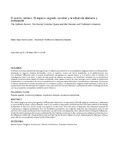Mostrar o rexistro simple do ítem
El acento católico: el espacio sagrado conciliar y la influencia alemana y protestante
| dc.contributor.author | García-Lozano, Rafael Ángel | |
| dc.date.accessioned | 2019-06-12T09:42:47Z | |
| dc.date.available | 2019-06-12T09:42:47Z | |
| dc.date.issued | 2017 | |
| dc.identifier.citation | García-Lozano, R. (2017). El acento católico. Actas De Arquitectura Religiosa Contemporánea, 5, 308-315. https://doi.org/10.17979/aarc.2017.5.0.5160 | es_ES |
| dc.identifier.issn | 2340-5503 | |
| dc.identifier.uri | http://hdl.handle.net/2183/23172 | |
| dc.description.abstract | [Resumen] El artículo comienza planteando la pregunta por la influencia protestante en la arquitectura religiosa católica contemporánea, abordada en algunos ámbitos territoriales, como el español, incluso de forma académica, y en publicaciones que han resultado referentes para la propia proyectación de iglesias en aquella época, y a la postre para el estudio y la investigación sobre este tema. A partir de este punto de partida, se analizan las influencias recibidas por la arquitectura religiosa contemporánea desde el ámbito protestante, tanto desde el punto de vista teológico como desde el meramente arquitectónico y constructivo, así como el papel llevado a cabo por otras influencias centroeuropeas relevantes. Finalmente el artículo desarrolla el acento aportado por la confesión católica a la arquitectura religiosa contemporánea a partir de las aportaciones tanto del Movimiento Litúrgico como más tarde del Concilio Vaticano II, poniendo de relieve el diálogo de éstas con las propuestas compartidas también por la Reforma | es_ES |
| dc.description.abstract | [Abstract] The article begins by raising the question of Protestant influence in contemporary Catholic religious architecture, addressed in some territorial areas, such as Spanish, even in an academic way, and in publications that have been related to the design of churches at that time, and for study and research on this topic. From this point of departure, the influences received by contemporary religious architecture from the Protestant perspective are analyzed, both from the theological point of view and from the merely architectural and constructive, as well as the role played by other relevant Central European influences. Finally the article develops the accent contributed by the Catholic confession to the contemporary religious architecture from the influences of both the Liturgical Movement and later by the Second Vatican Council, emphasizing the dialogue of these ones with the proposals also shared by the Reformation | es_ES |
| dc.language.iso | spa | es_ES |
| dc.publisher | Universidade da Coruña | es_ES |
| dc.relation.uri | https://doi.org/10.17979/aarc.2017.5.0.5160 | es_ES |
| dc.rights | Atribución-NoComercial 4.0 España | es_ES |
| dc.rights.uri | http://creativecommons.org/licenses/by-nc/3.0/es/ | * |
| dc.subject | Espacio sagrado | es_ES |
| dc.subject | Arquitectura religiosa | es_ES |
| dc.subject | Arquitectura alemana | es_ES |
| dc.subject | Arquitectura protestante | es_ES |
| dc.subject | Sacred space | es_ES |
| dc.subject | Religious architecture | es_ES |
| dc.subject | German architecture | es_ES |
| dc.subject | Protestant architecture | es_ES |
| dc.title | El acento católico: el espacio sagrado conciliar y la influencia alemana y protestante | es_ES |
| dc.title.alternative | The Catholic Accent: The Sacred Conciliar Space and the German and Protestant Influence | es_ES |
| dc.type | info:eu-repo/semantics/article | es_ES |
| dc.rights.access | info:eu-repo/semantics/openAccess | es_ES |
| UDC.journalTitle | Actas de Arquitectura Religiosa Contemporánea | es_ES |
| UDC.volume | 5 | es_ES |
| UDC.startPage | 308 | es_ES |
| UDC.endPage | 315 | es_ES |






